Haz clic aquí para leer en español
*Written by Neon*
We resupplied in La Paz and went out to a small outpost of Milluni, nestled near the base of Cerro Huayna Potosi- a towering mountain skirted with glaciers. Leaving Milluni, we immediately began our ascent to our first pass in the Cordillera Real. Beginning at an elevation of around 4,000 meters, we ascended for half the day up to around 5,100 meters and crossed over into the next valley. Descending to a small group of huts, we realized it was a refugio area and ate a snack in the shelter of the small buildings. As we left our refuge, the wind died down and the hail began. Thankfully we were prepared. The hail died down and we marched on along the valley to find camp for the night. We ended up following an aqueduct to a group of ponds and set up our tent between a couple of them to tuck in for the night.
The next morning, we set off to cross another pass. I was surprised at how rested I felt- I don’t normally sleep well above 10,000 ft(3050 meters). We continued along the expansive valley most of the morning, before gaining elevation at another pass right as the lunch hunger set in. Luckily, we were able to stop for some lunch and continue up the pass in front of us. We crested in the early afternoon, and headed down hoping to cross the next pass a mere five kilometers and 1,000 meter descend and re-ascent away. Fidgit and I made it to the bottom of the valley in the late afternoon/early evening and decided to set ourselves up for success and not try and climb over another 5,100 meter pass. There was a camping area at one end of the valley, but we didn’t want to pay to set our tent up so we headed to the base of the next climb. There, nestled into the base of the mountains, we found a small building. It turns out a group of people from down the valley came up and built a refugio together. As the evening winds picked up and the clouds descended, we decided to pay a small fee to stay indoors that night.
Waking up the next morning slightly refreshed, we made our way up and up to the top of the pass. As we neared the apex, I crossed some small snow patches and my oxygen-starved brain was taken back to the last time we had snow on the trail- in Northern Patagonia. I reminisced my way to the top of the pass, where Fidgit was patiently waiting to descend. I got ahead on the descent, and found myself standing on a ledge above a glacial lake, looking to my left at a cairn on the ledge next door.
As I began my descent, a small man showed up at the bottom of the rocky area, asking if I was OK. I replied and continued picking my way down with his watchful eyes on me. Fidgit showed up at the ledge and asked the guy at the bottom if this was the way down. “Si, son piercas!”, he replied as I reached the ledge with the cairn on it and Fidgit began making her way down/across. I made a loud noise with my poles, and the man ran up from the base of the rocks to make sure we were OK. He then helped us the rest of the way down the trail/down climb area, and, ignoring his own clients who had huffed their way up and were resting, walked with us to an overlook and pointed out the trail to take down the valley along a lake. We made our way down and along the lake to the base of the next ascent and stopped for lunch. We began talking about our gratitude that along this journey, people seem to show up at the exact right time. I don’t know how it happens, and I continue to be so thankful for it.
After lunch, we ascended to a high point which, sitting at a mere 4,700 meters seemed much lower than the 5,100 meters we had just come over. We came down to another valley and discussed the next pass, which was even lower in elevation. It was still early enough, so we began our ascent. As we went up, some clouds rolled in and we got to experience our second hail storm of the Cordillera Real, this time with the added bonus of thunder! With no trees having been in sight for days, I was grateful that I didn’t see any lightning because we had no choice but to be out in it. The storm rolled through quickly, coating everything in white, and chilling the air. We made it up and over the pass, descending to the edge of a larger valley and finding a lower place to camp for the night. I fell asleep quickly after dinner, exhausted by our 3-pass day.
Waking up the next morning, we began our descent further into the valley. I was tired from the day before and grumpy, so I just followed Fidgit. We ended up having to go down and around the valley to go back up the other side. It was longer than I would’ve liked, but it got us where we were trying to get. We made our way over another high point, coming upon a herd of llamas and their keeper along the way. As we made our way down across and into the next valley, I realized we had made it to the valley that we planned to cross from the western side of the mountains to the eastern side. I was interested in seeing what the other side of this range would look like, so I pushed myself harder again that afternoon. We made around 2 giant glacial lakes that took up most of the valley floor, and up to another lake before finding a camp spot and stopping for the evening. I crawled into my sleeping bag that night more weary than I had felt in a long time, and slept soundly even at the 4,300 meter elevation.
Waking up sore though ready, and adjusting more to the elevation daily, I was prepared for the next pass. It ended up seeming like nothing because it was on a dirt road and we had already done most of the climbing. So, up and over and down we went, and ate lunch at the base of our first eastern side of the Cordillera pass. After lunch, we headed up and I noticed a pretty immediate difference- there were far more trails on the east side of these mountains. At least noticeable trails going up and over the pass. This meant to me that more humans (with or without animals) traveled through this area than the western side of the mountains. We had heard that before, which may color my perspective a bit, but the noticeable difference in trails was more evidence. Reaching the pass, we immediately began another steep descent into a valley that we would follow. The valley from above looked like a giant marsh, so I was relieved when I looked on the GPS and saw a trail that descended more gradually along the side of the valley to keep us out of it. We made it to where two valleys came together, and set up for the night.
The next day, we spent most of our time climbing up and up this beautiful wide valley with its glacier-fed river flowing along beside us. We- you guessed it- reached the pass and began making our way down into another valley. Still tired, we made it to the base of our descent and set up for the night. At this juncture, we knew we wouldn’t make it to our next planned resupply town of Sorata in the time we had planned to, and were running low on food. Thankfully, we looked ahead along our route and saw that there was a small town a day or two before Sorata. We began hoping and planning to at least find something there to sustain us through to Sorata.
We also had one more pass to go over before we would be in the valley with the small town, so we rested up and pushed on the next morning, with lighter packs and determination. It took us into the afternoon to get over the pass, but along the descent the trail meandered down and was easy to follow. We made it to town by early evening, and to our pleasant surprise it was bigger than expected. The town’s children told us where the small store was, and then asked us for candy. We didn’t give them any, though they stuck around anyway to gawk at the gringas until their parents or older siblings pulled them away. We hung out in town, repacking our food and snacking, then moved on to find camp for the night up the valley.
The next morning we headed off, relieved to have found food, though I wasn’t excited about making my pack heavier right before a steep climb. Up and out of the lush valley we went, following along a mostly visible path towards the next pass. We ran into a guide and his charges near the top of the pass, and Fidgit did some information gathering with the guide as I talked to the charges. We continued up and the weather was nice enough at the top of the pass that we had lunch up there, blocked from the wind by a large cairn. We then went down. Near the bottom of the valley, we tried to forge our own way to avoid dropping as far in elevation before once again gaining it. Failing miserably, we did have another adventure in bushwhacking, as the first trees we had seen in days showed up quite inconveniently. Making our way up part of the next pass so we would be once again set up for success, we found some water and a flat area for our tent. Settled in for the night, I wrapped my sleeping bag around me and talked to the nearby cows as my dinner was cooking.
Going over the last pass before Sorata was tiring, so much so that we attracted a few condors near the top. They rode the thermals lazily above us as I huffed and puffed up to the 4,800 meter pass. Getting to the top in the late morning and then carefully negotiating the scree field on the other side was very tiring for me, so I greatly enjoyed our lunch break that day. Fidgit wasn’t in a talking mood and was moving slowly, so I assumed she was also quite tired from this last week and a half of effort at high elevation. We chugged our way down towards Sorata- the lowest elevation we had been at in many days at 2,600 meters. It was a beautiful walk, though it was also tough to see where you are going from so far away and not be able to get there any faster. We ended up making it into town right around dinner time. Another successful section done reminded me that even though they can be brutal and exhausting, I much prefer mountain walking than walking along flat, boring areas.
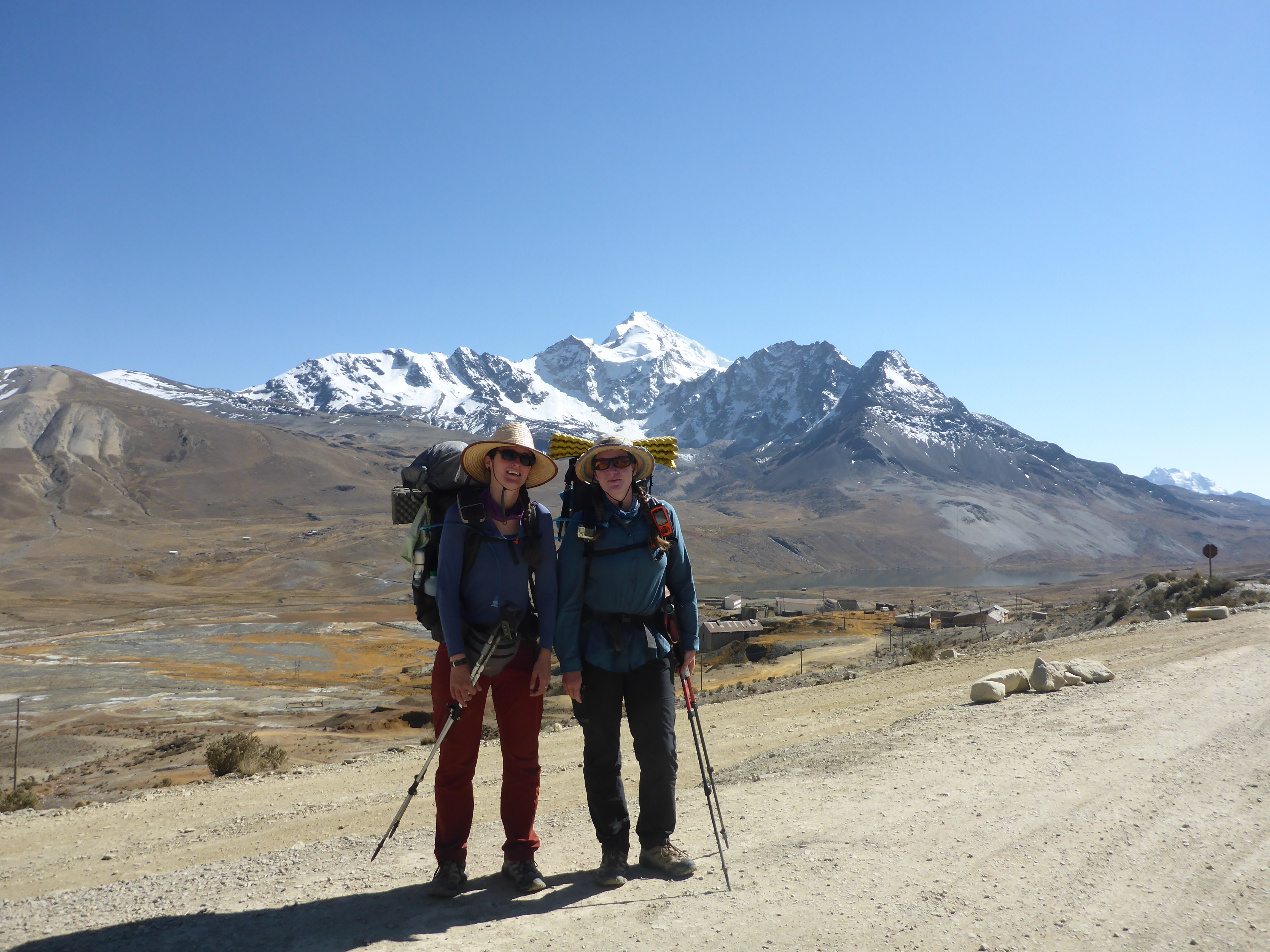
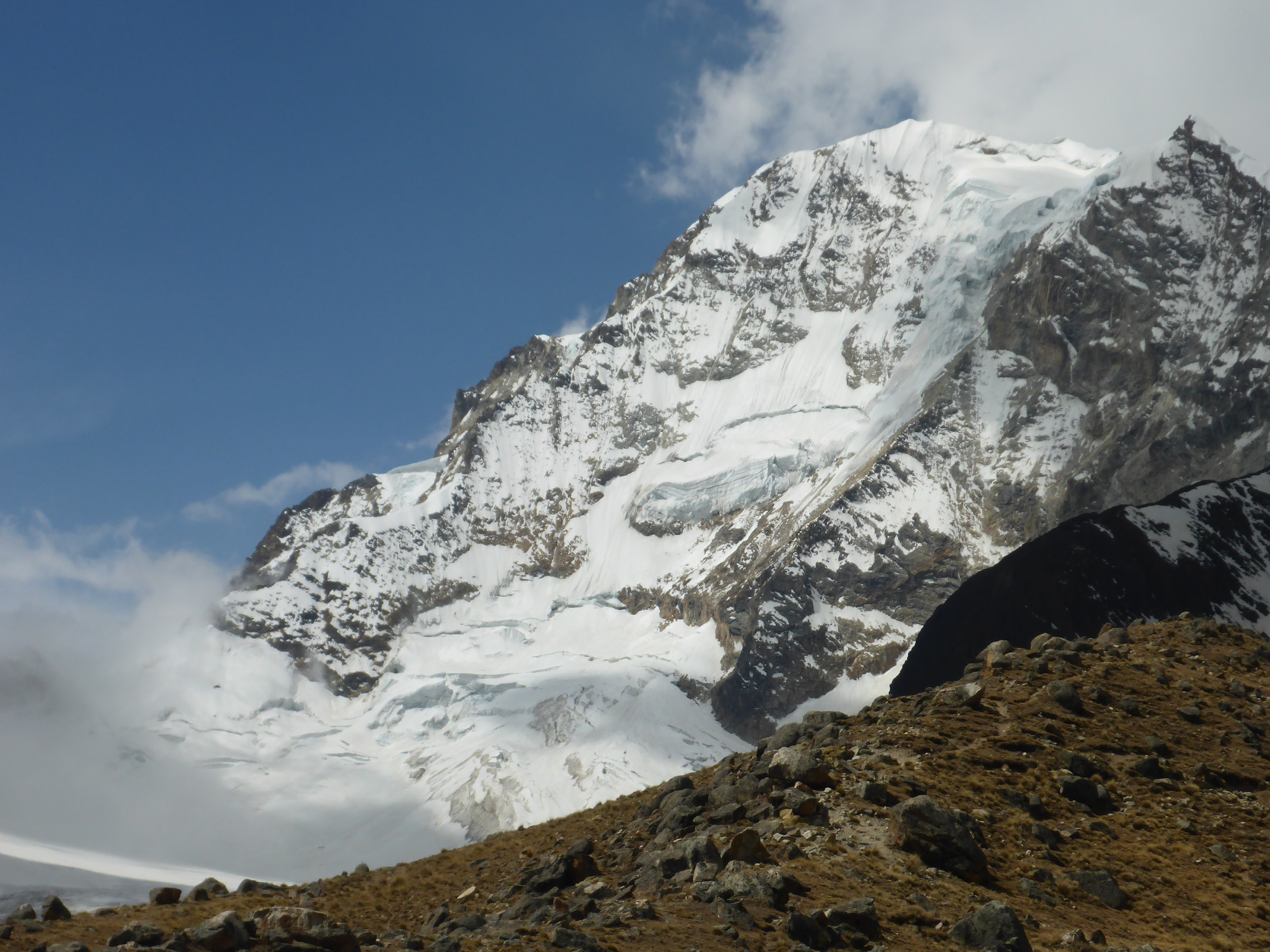
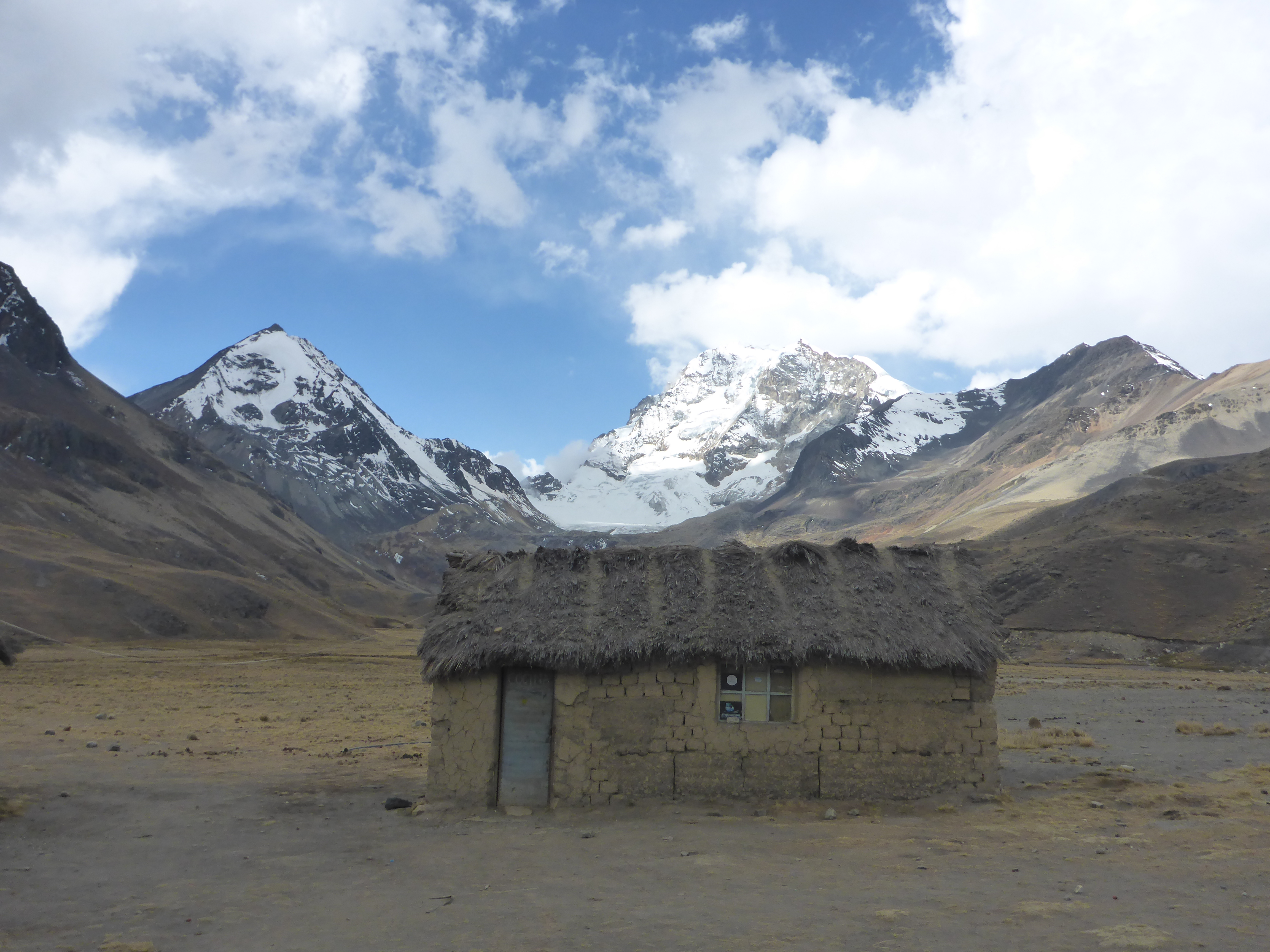
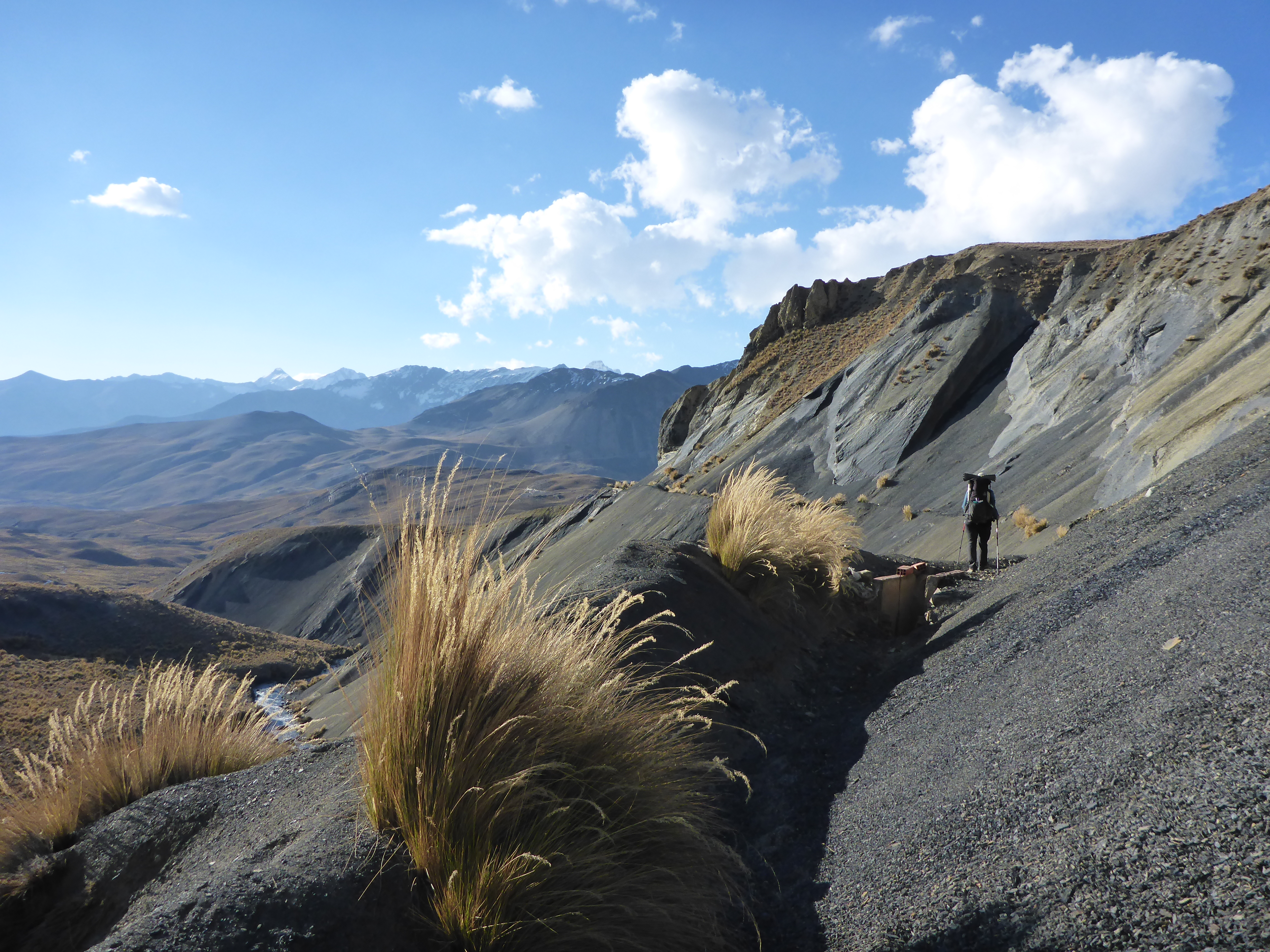

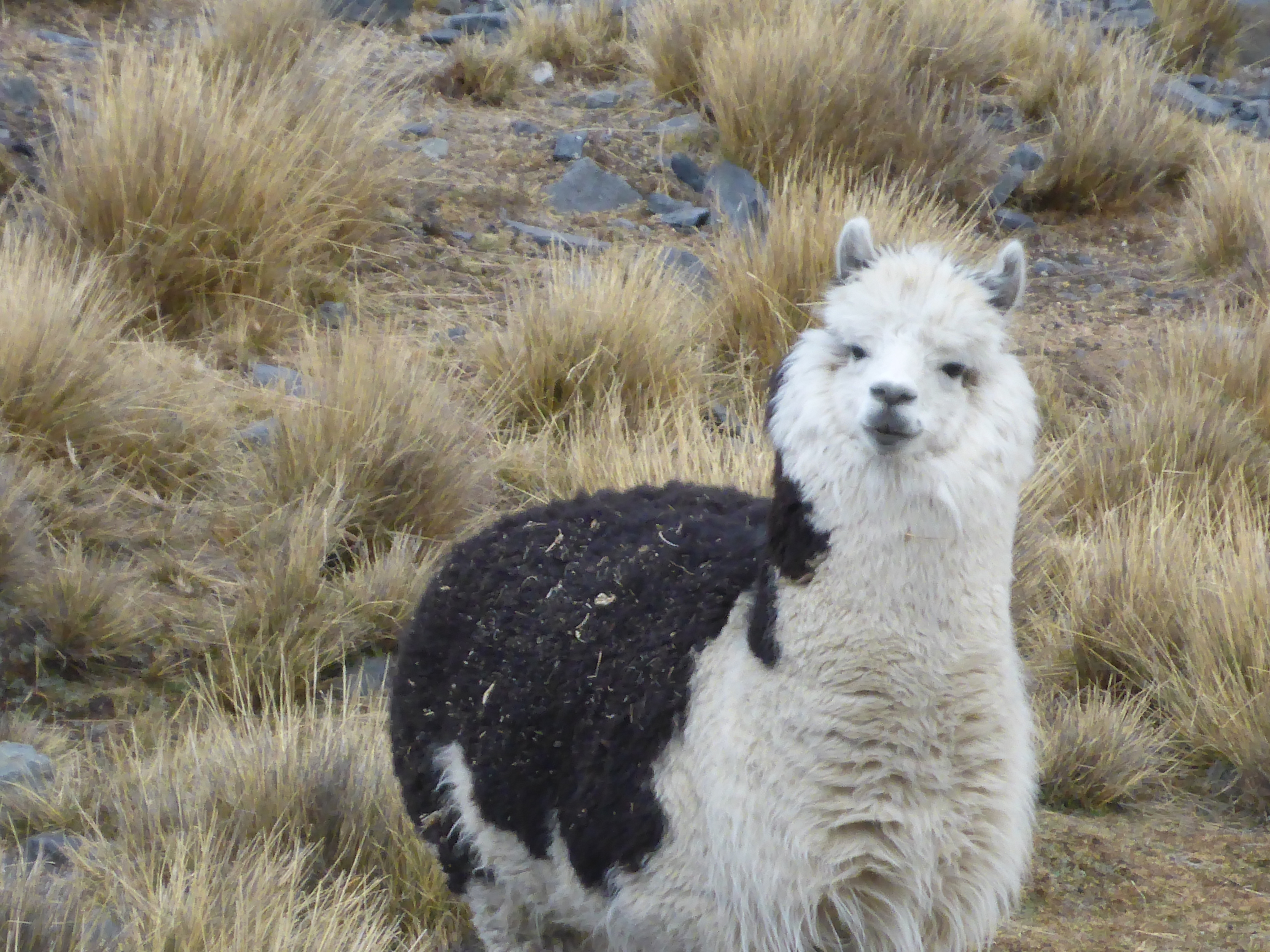
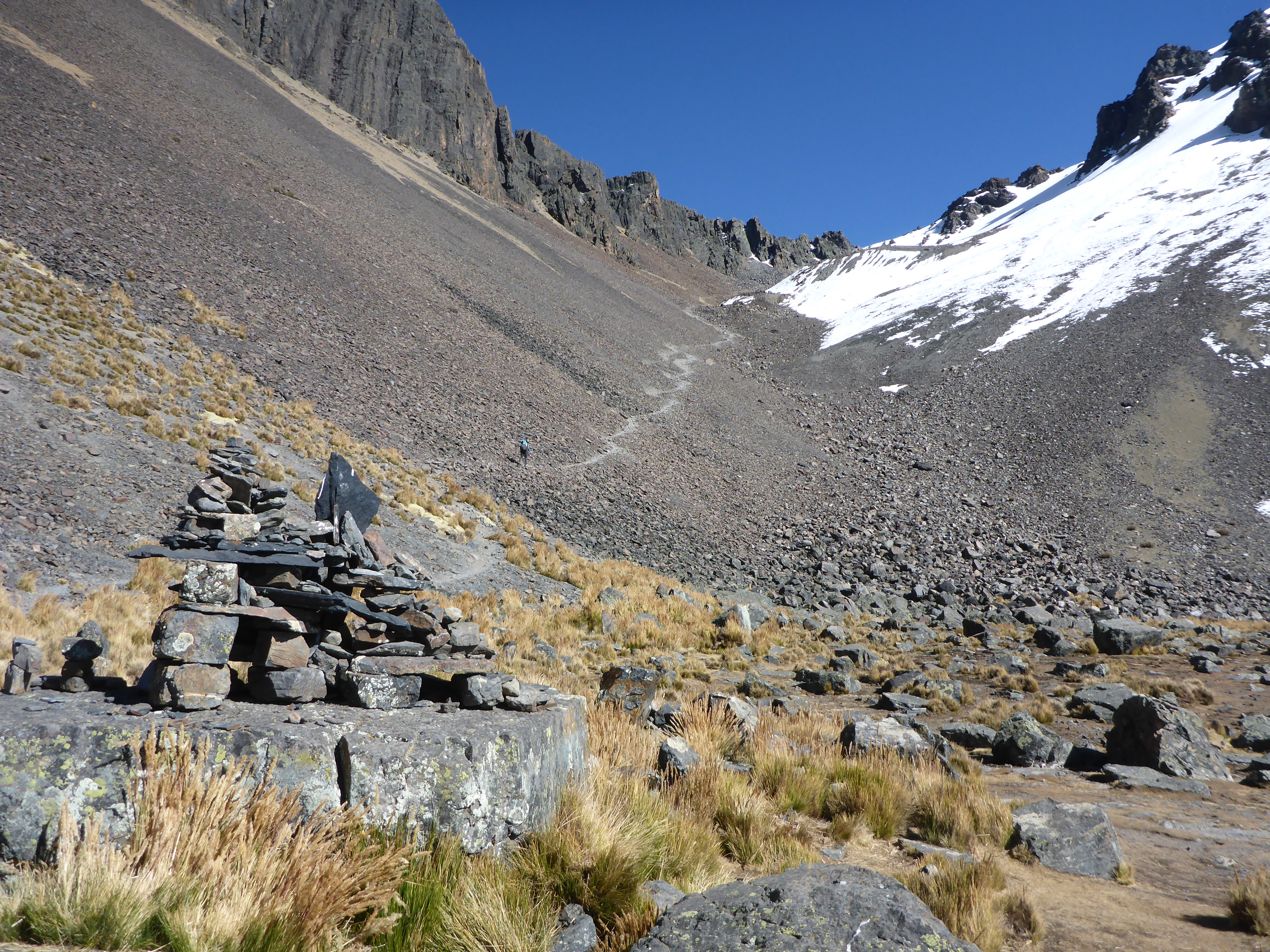
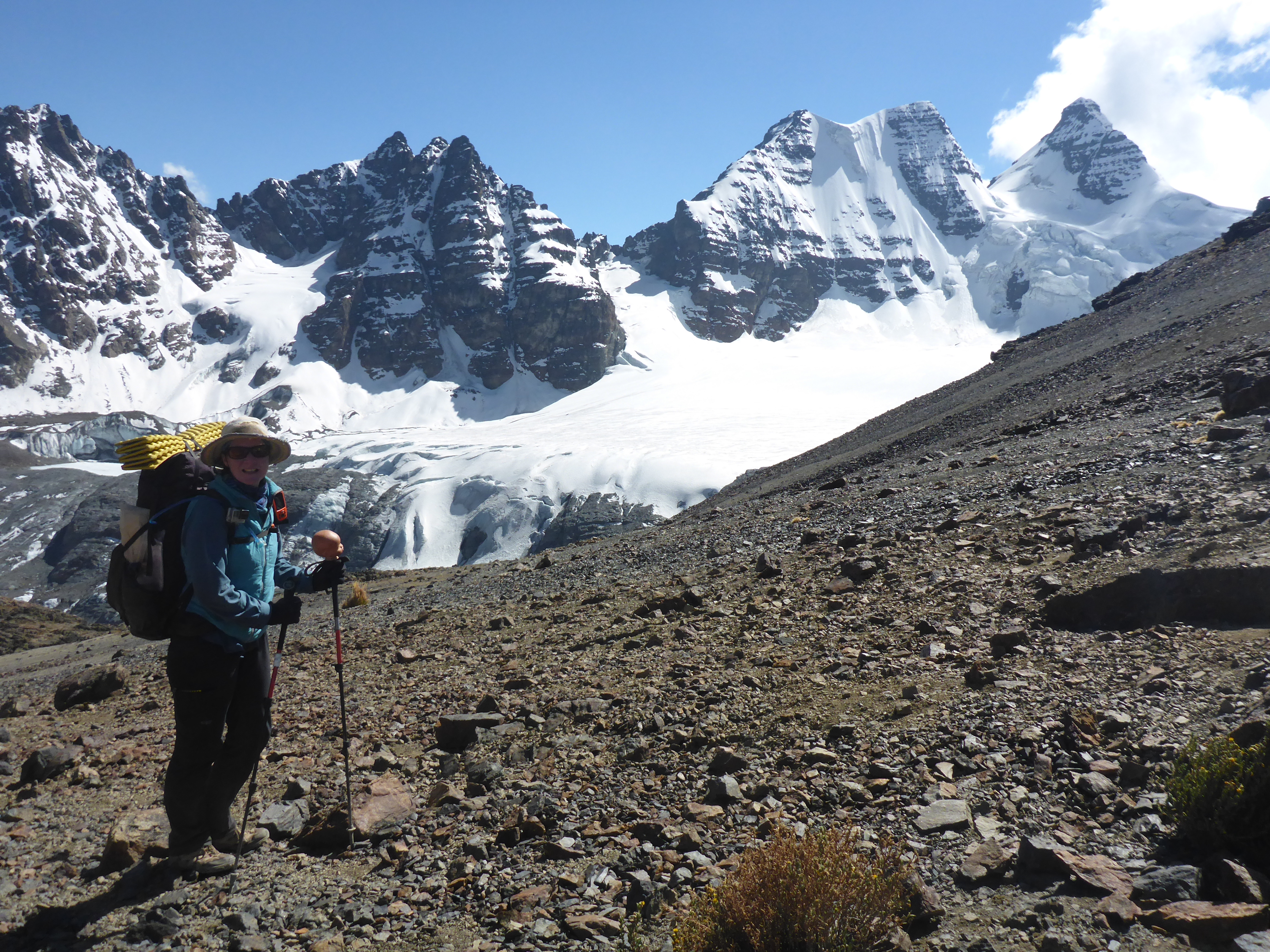
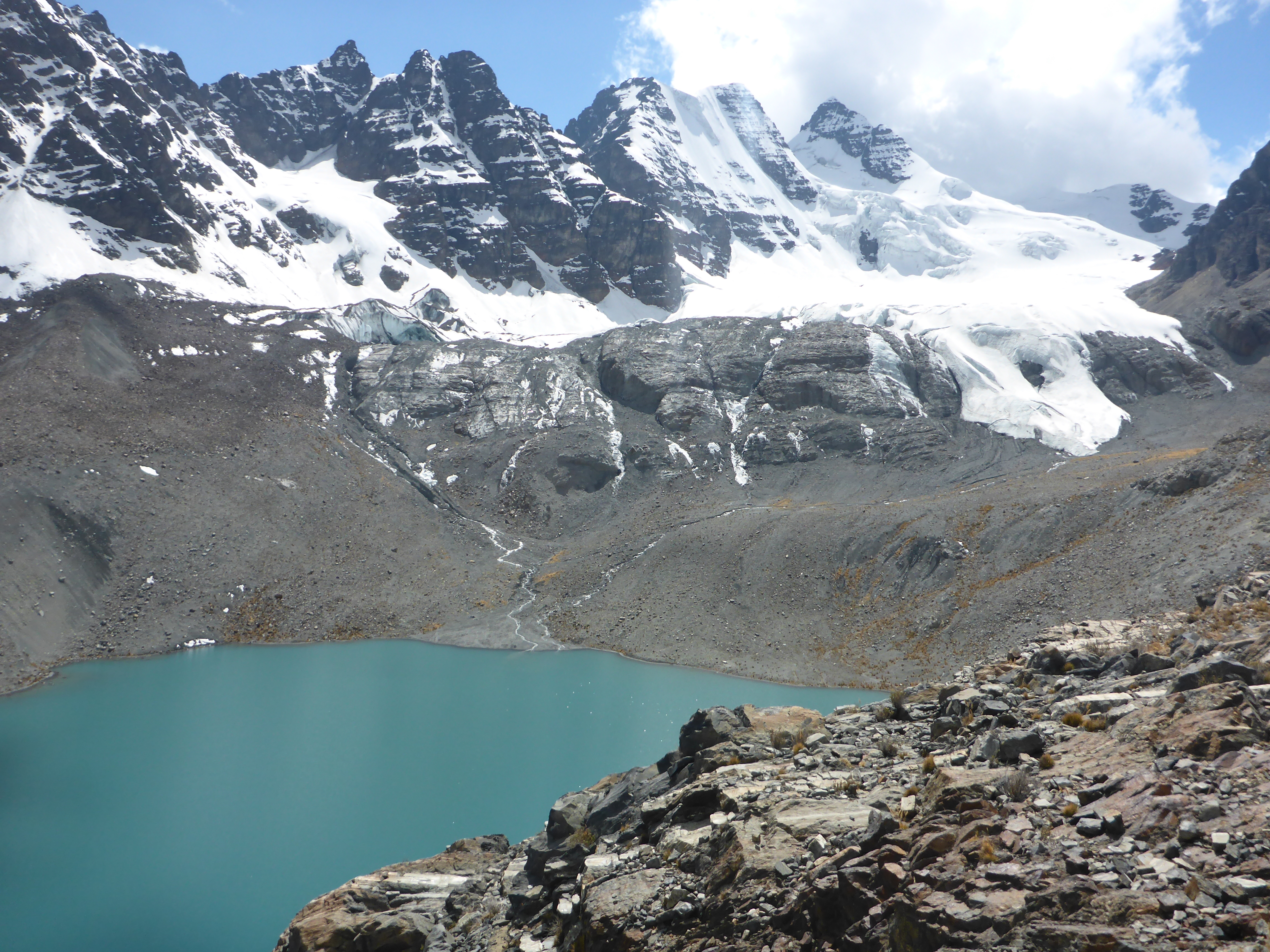
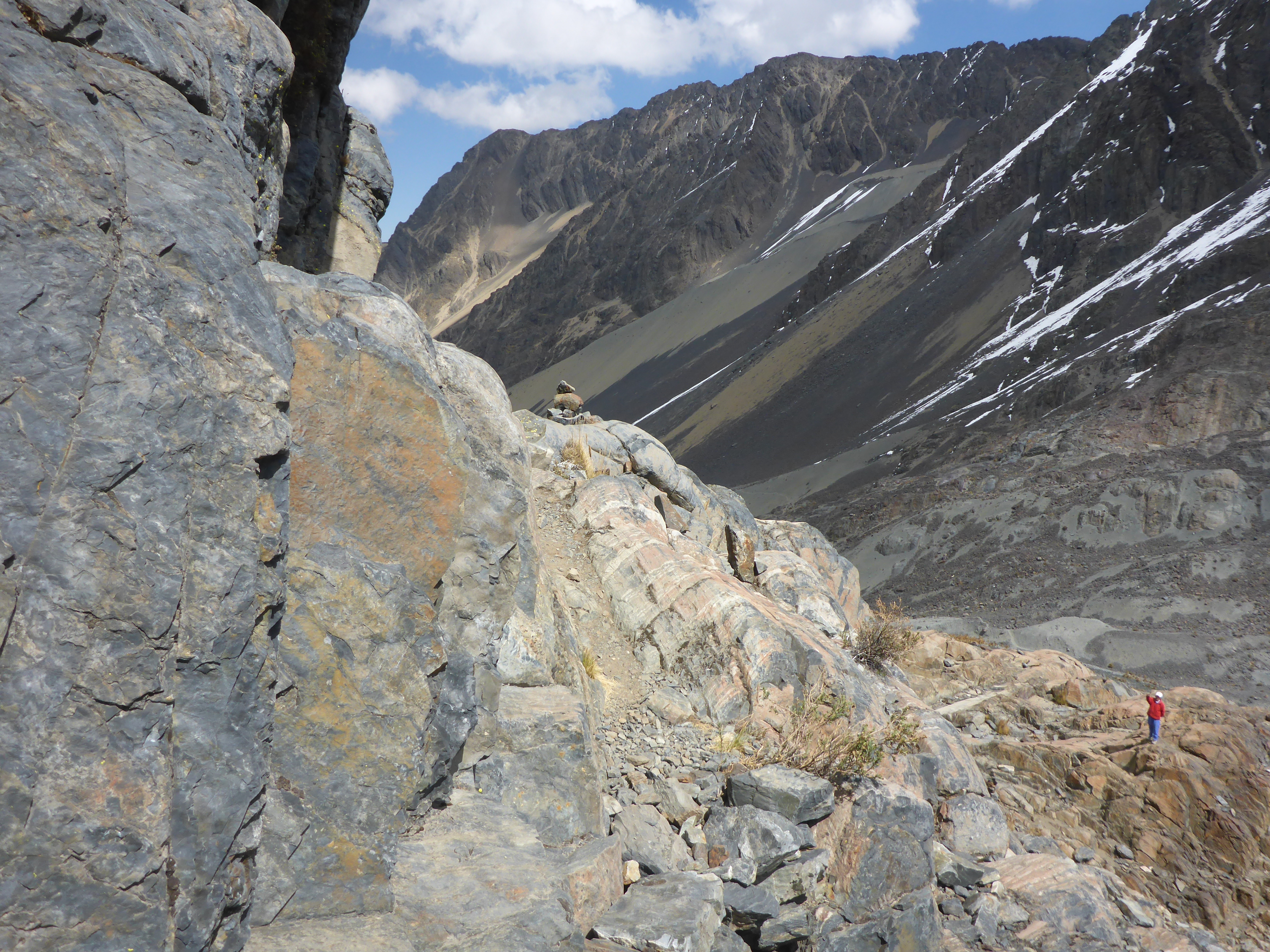
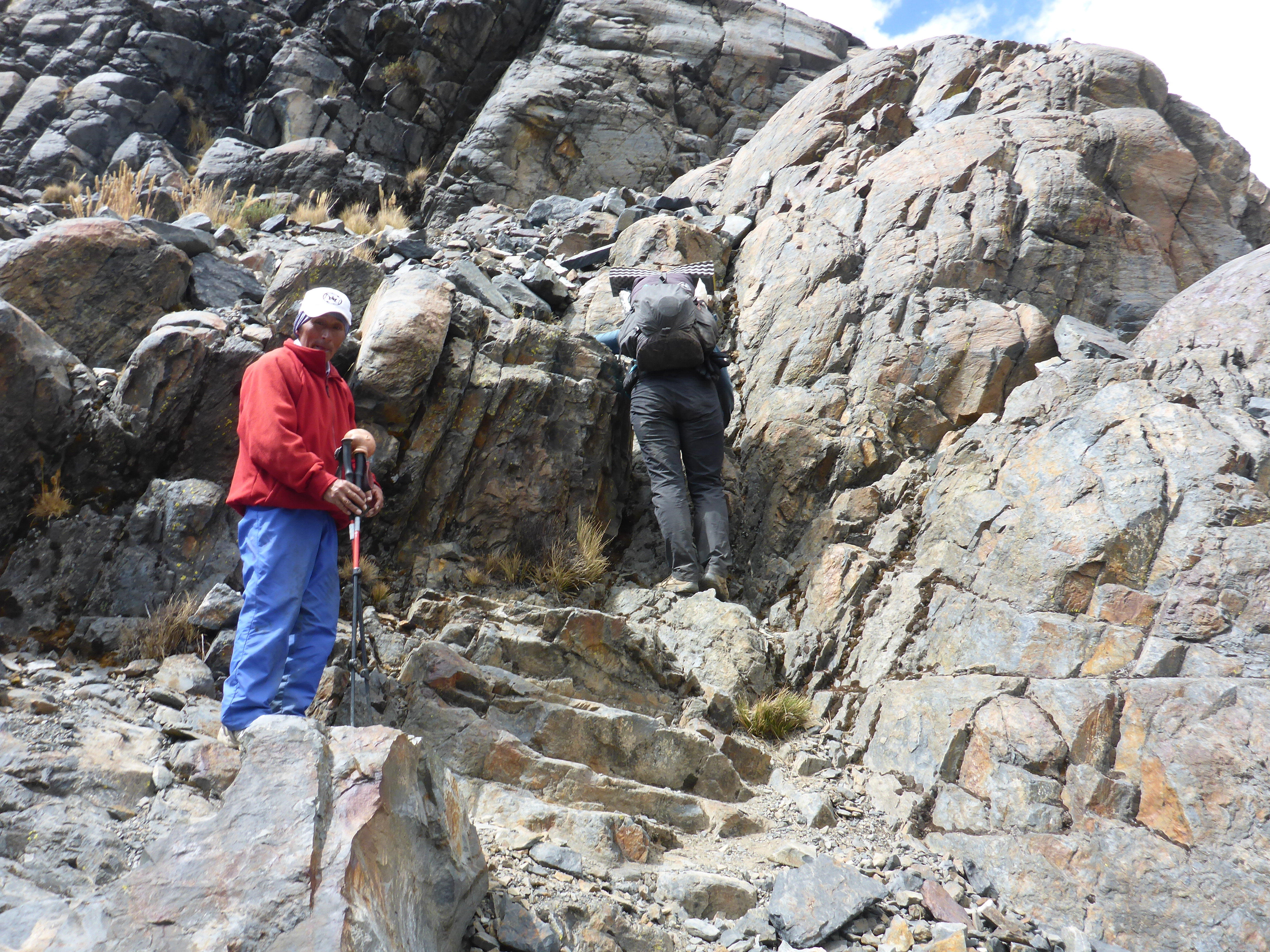

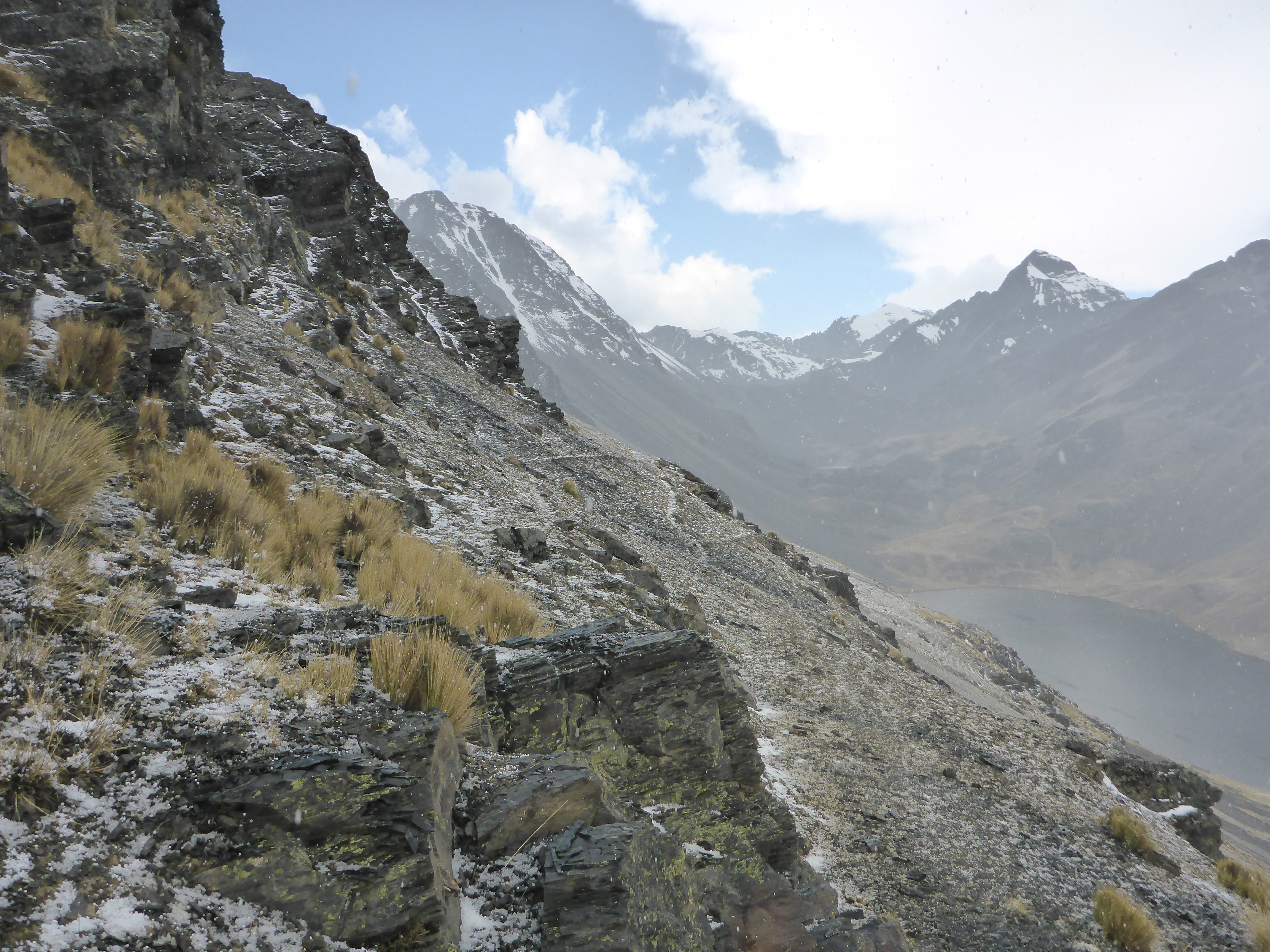

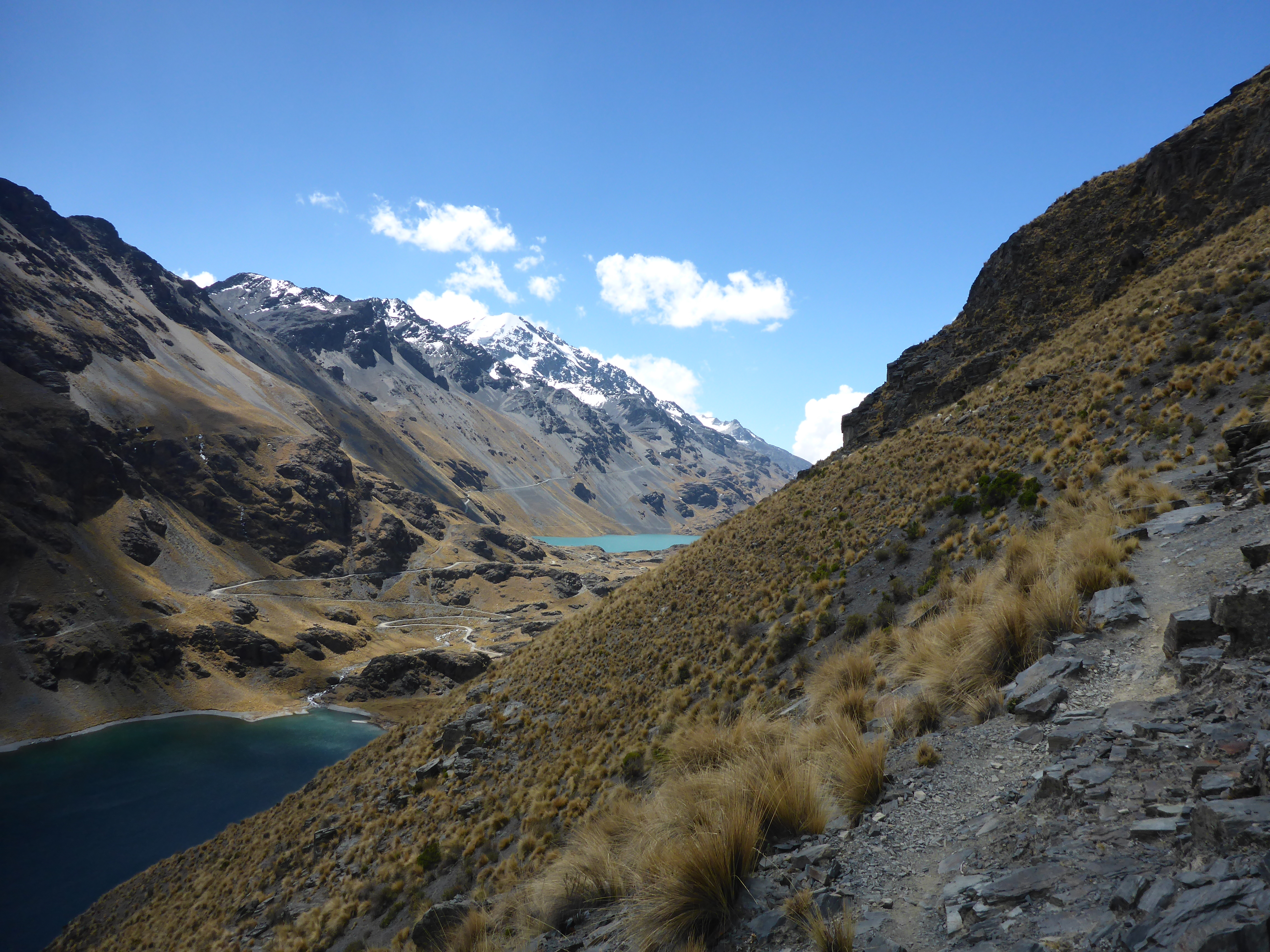
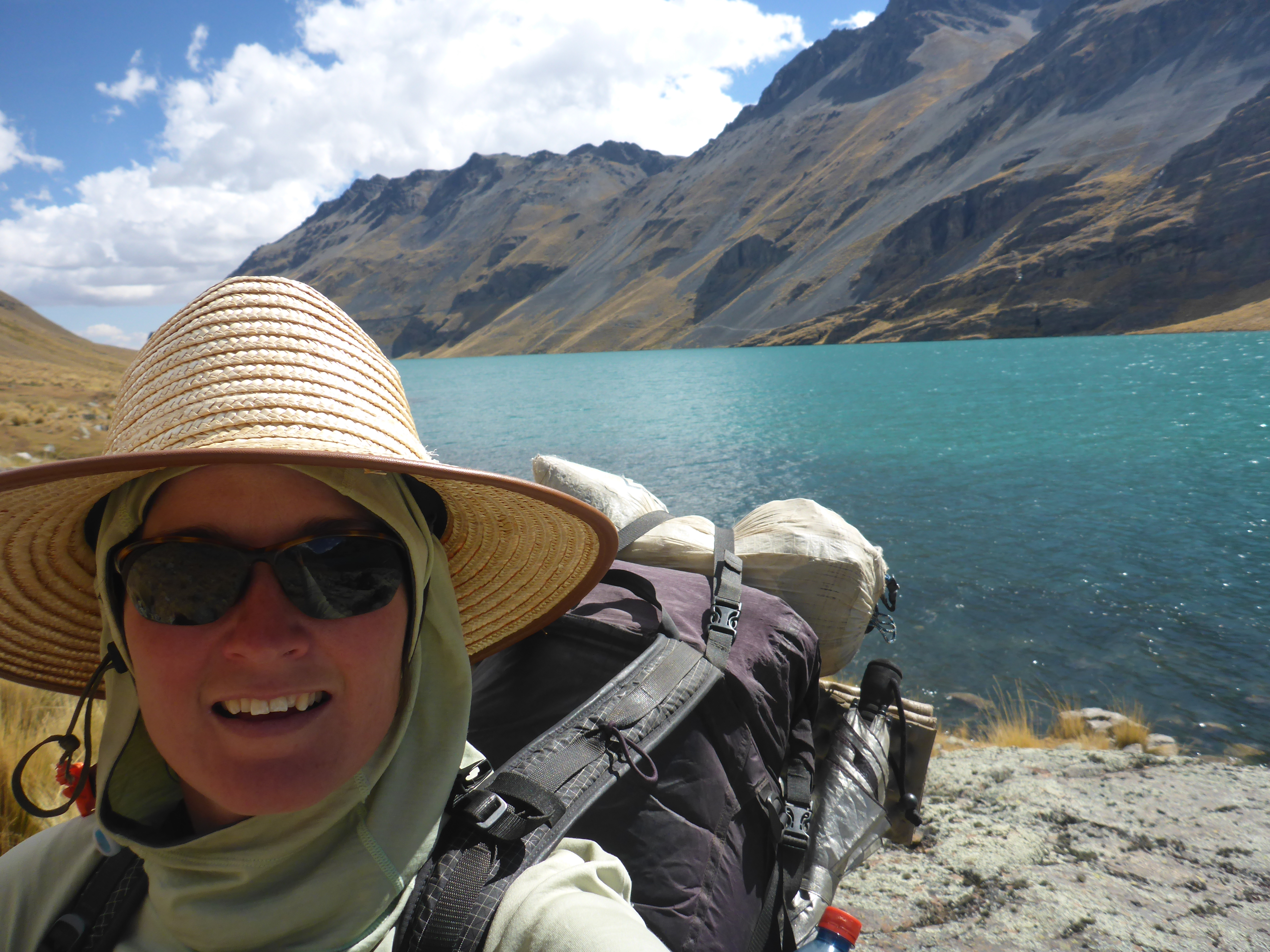
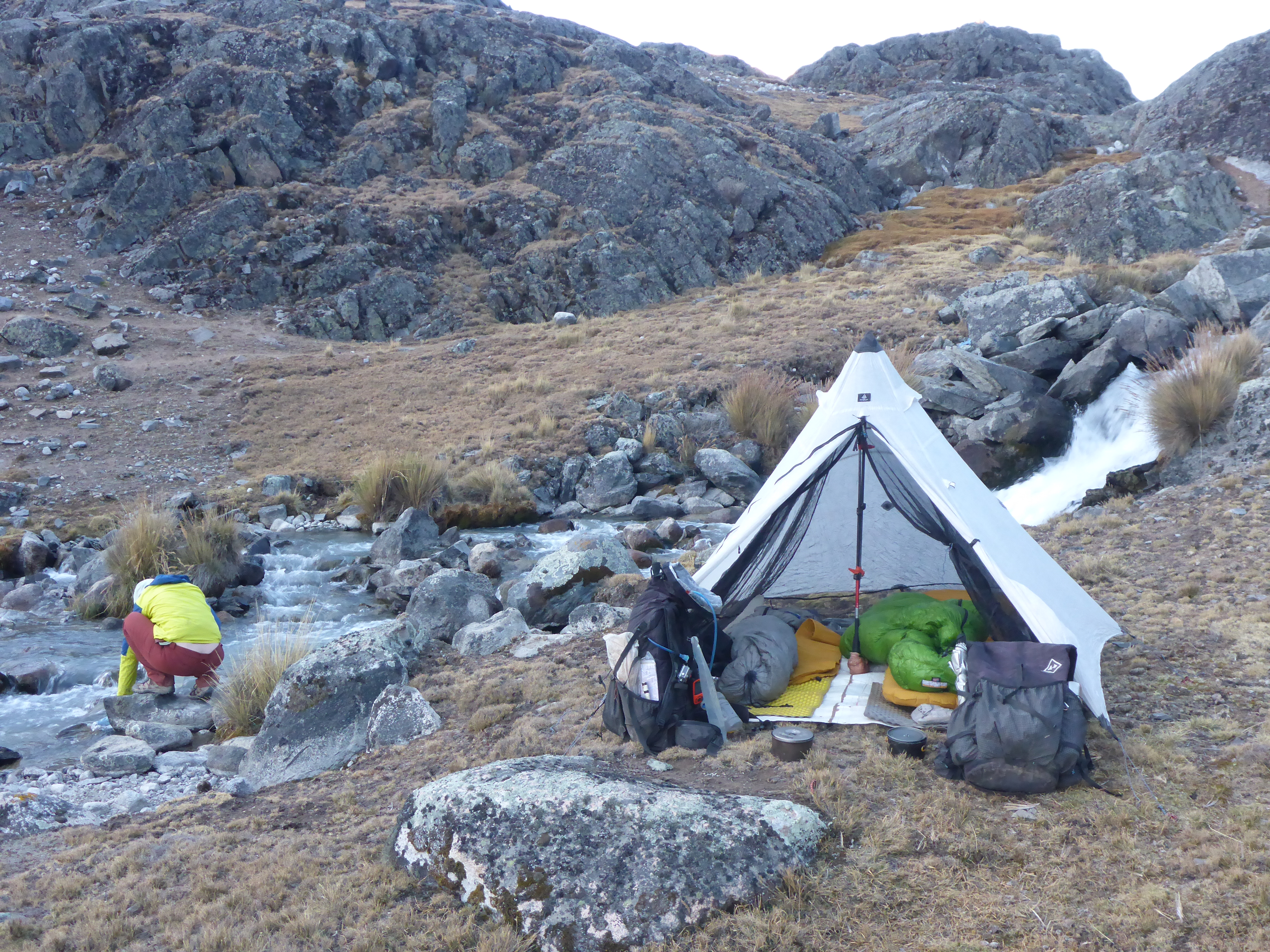
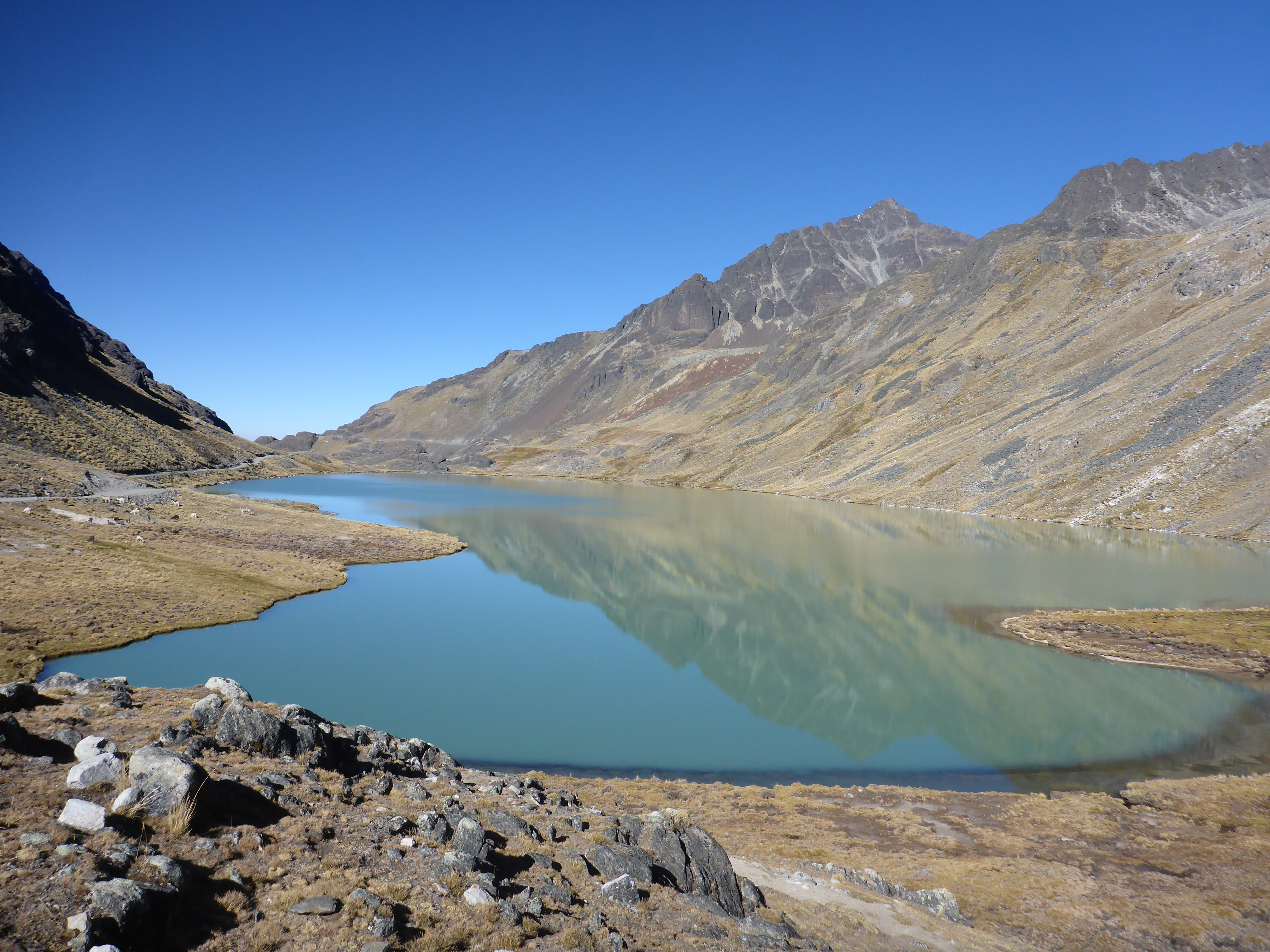
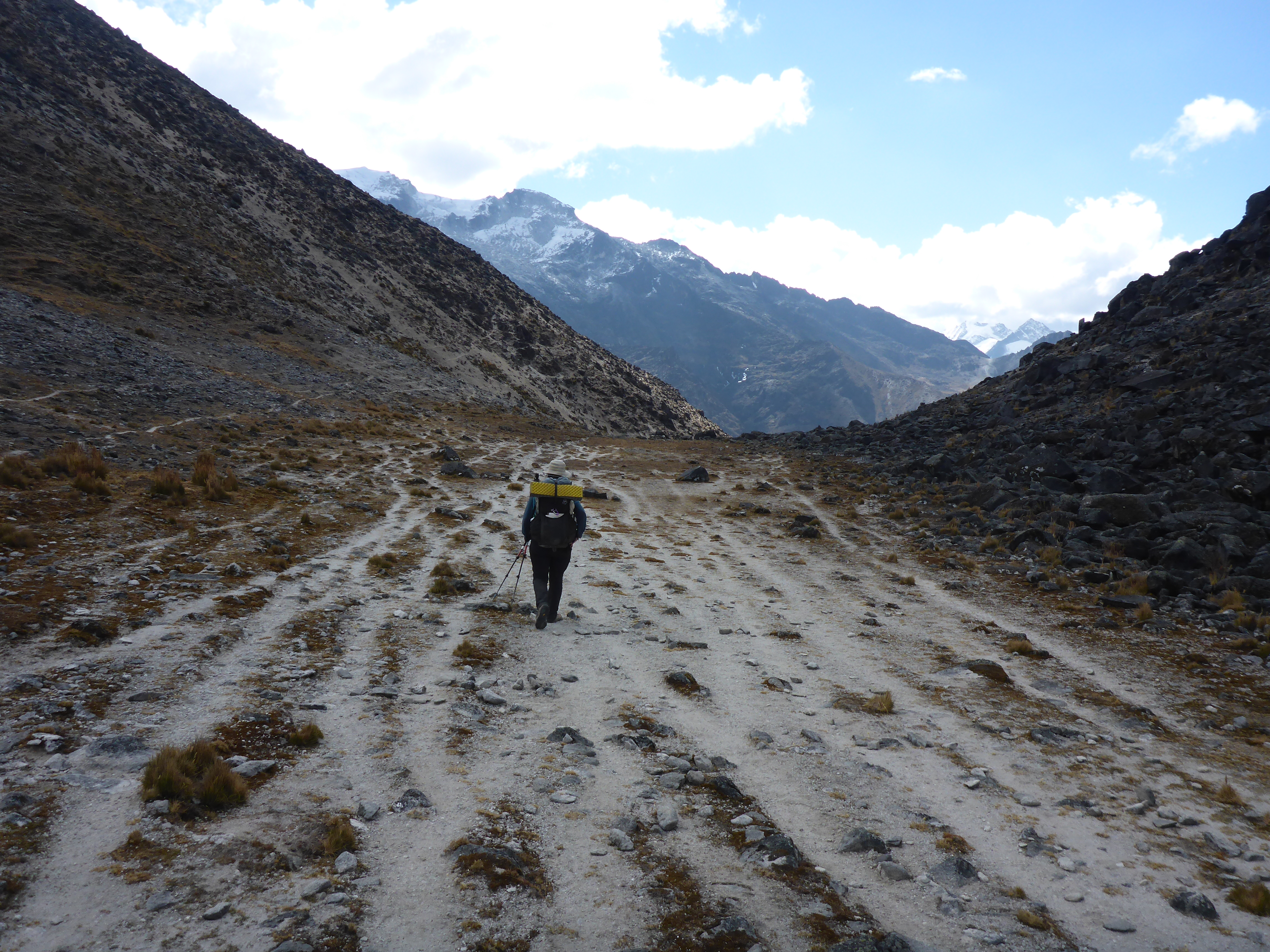
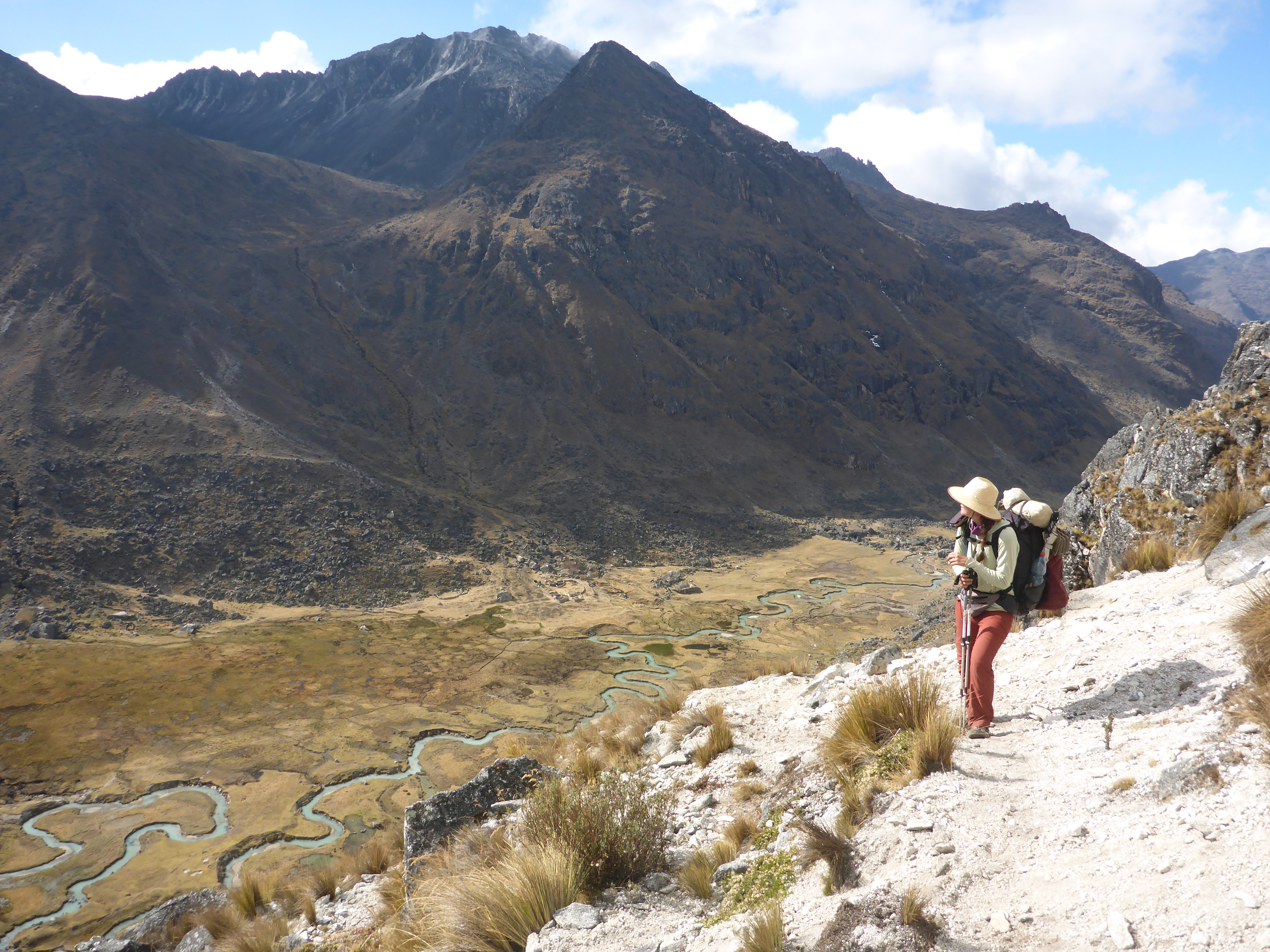
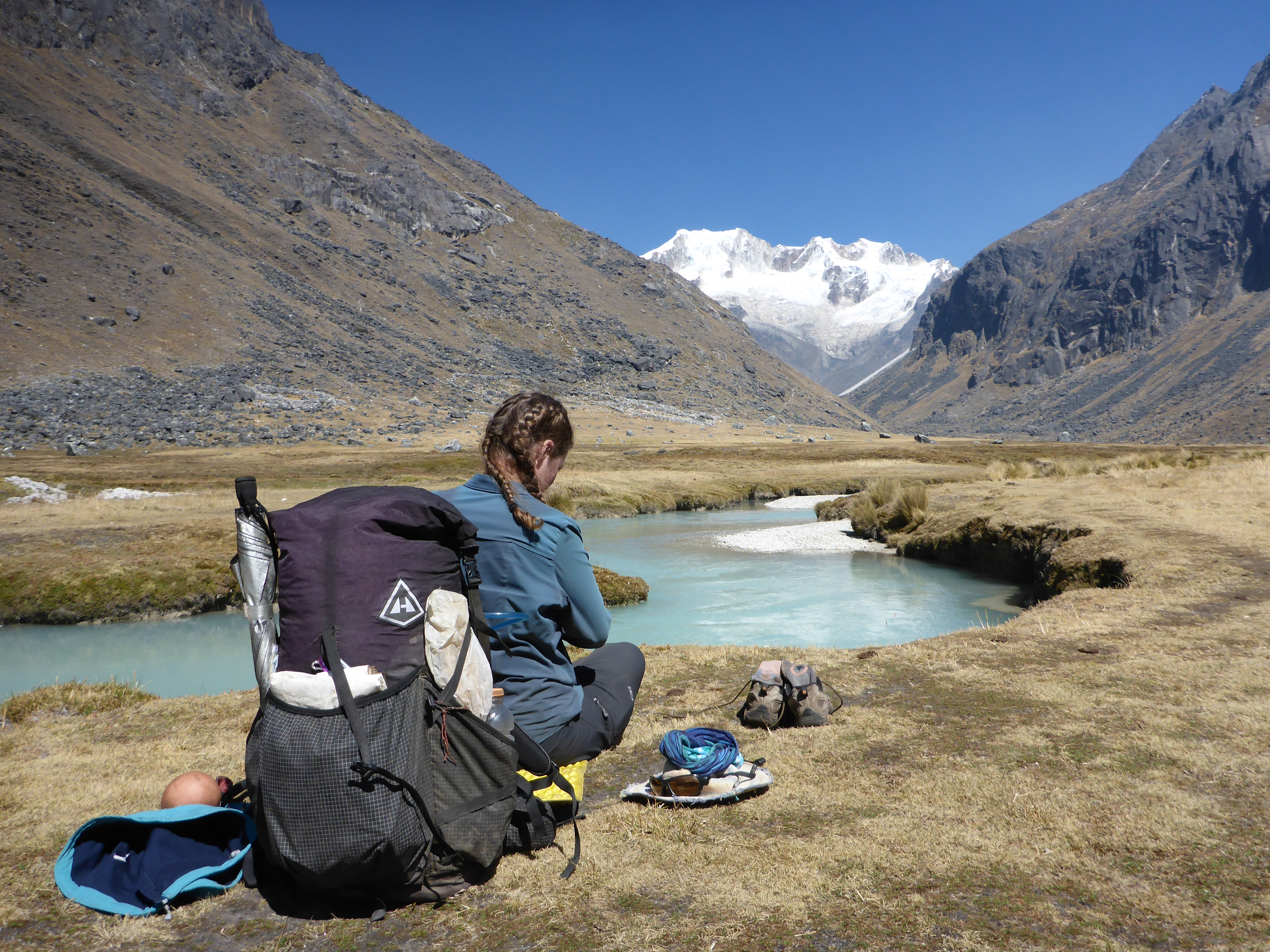
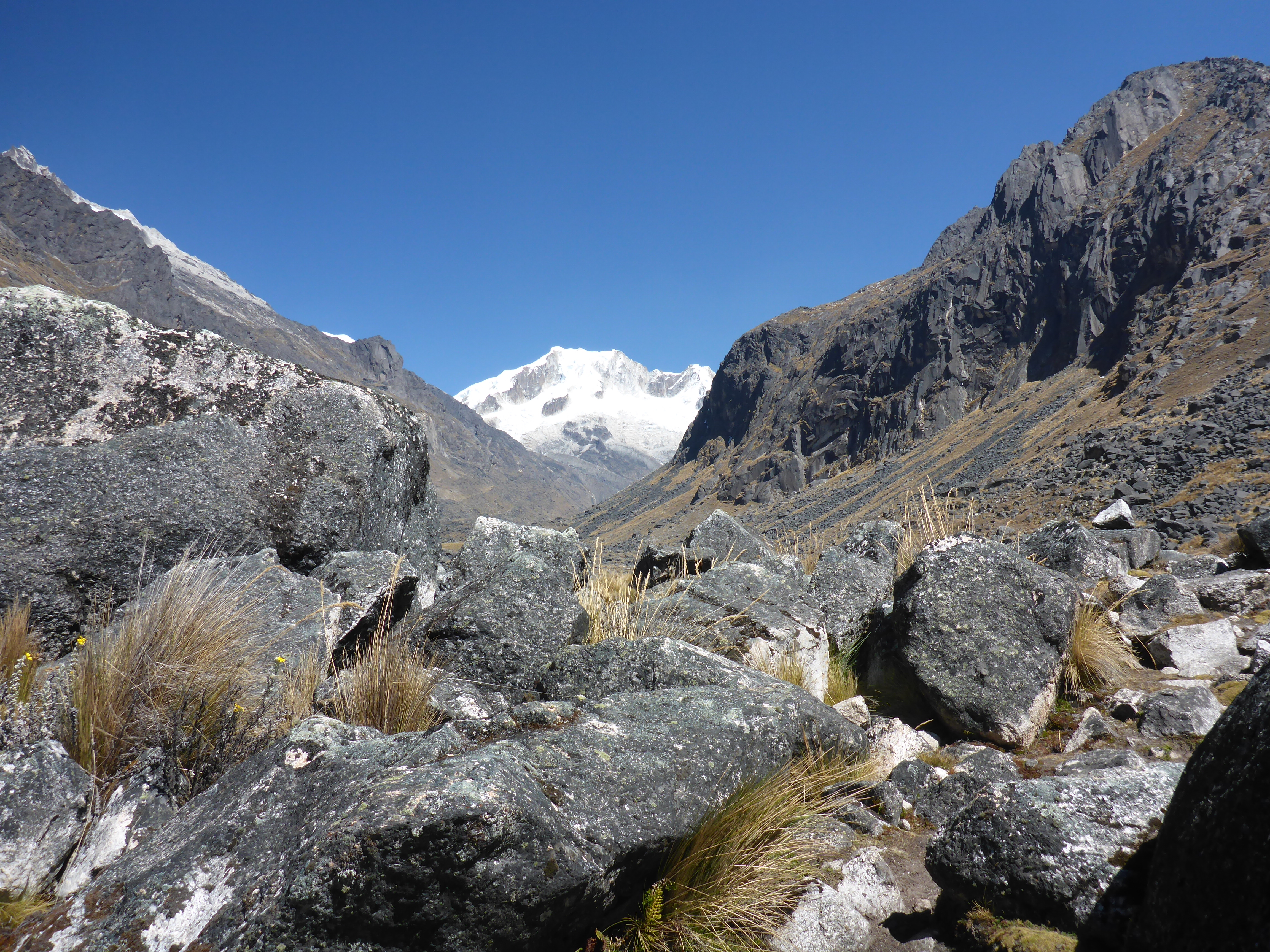
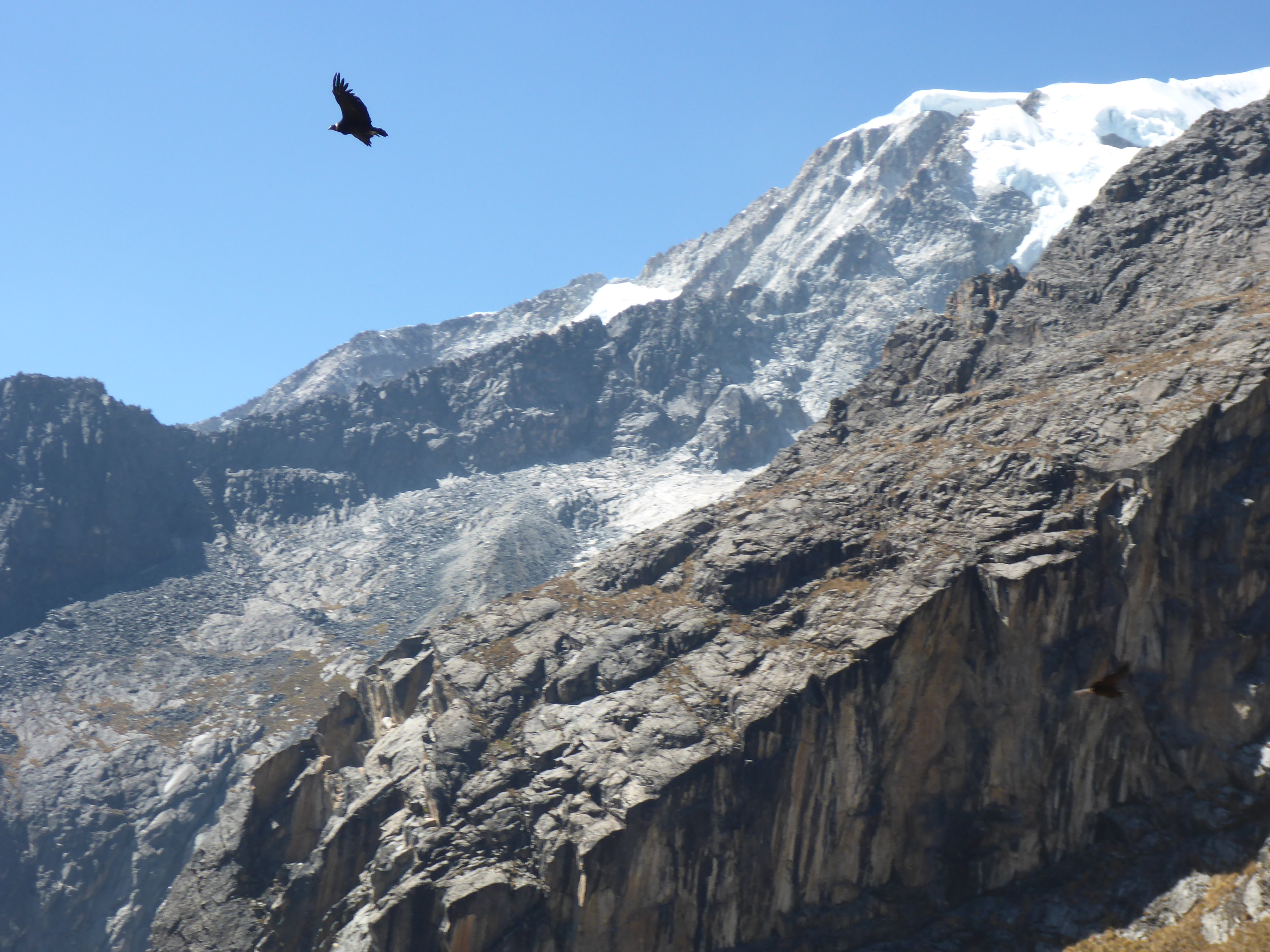
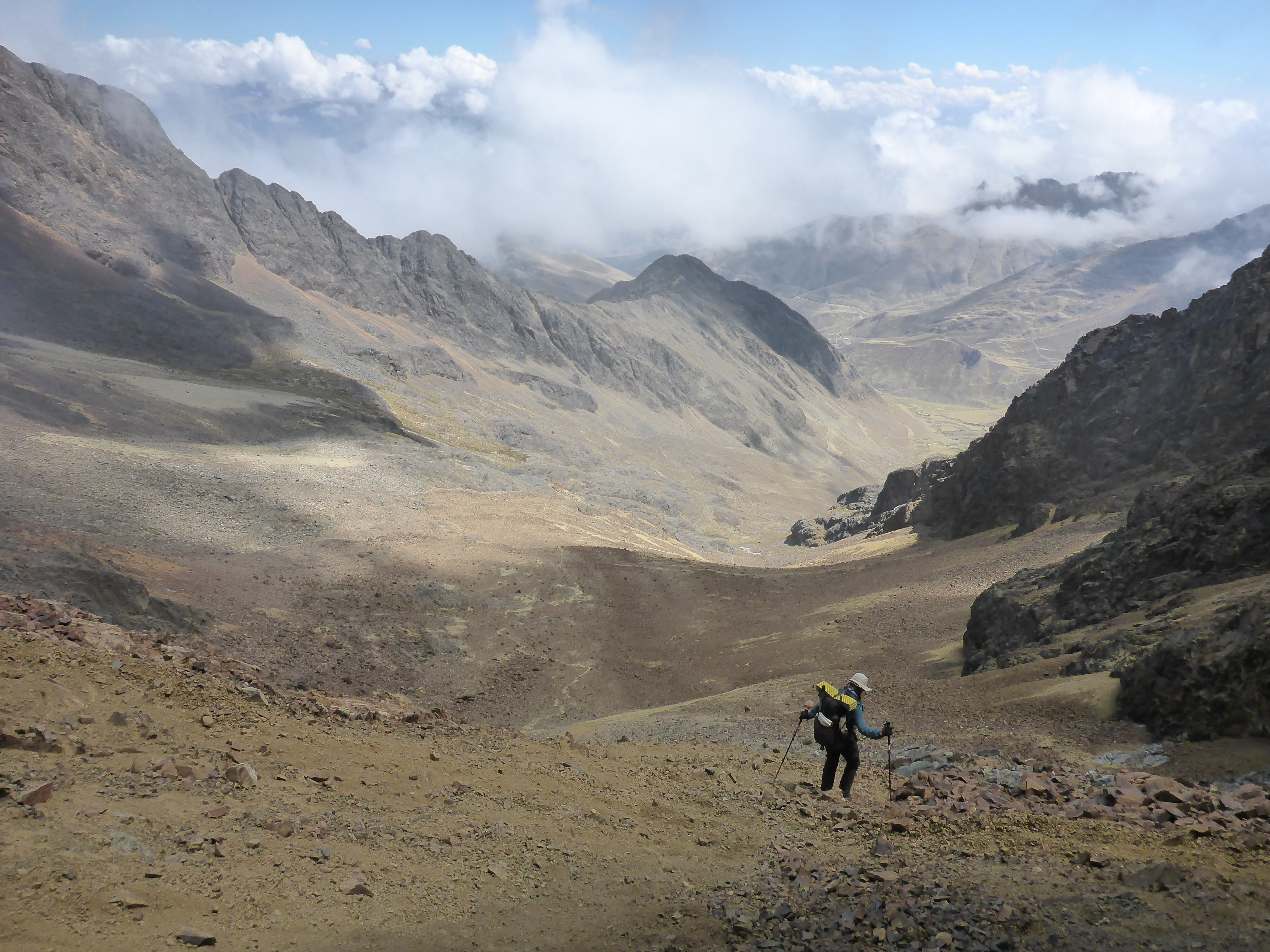
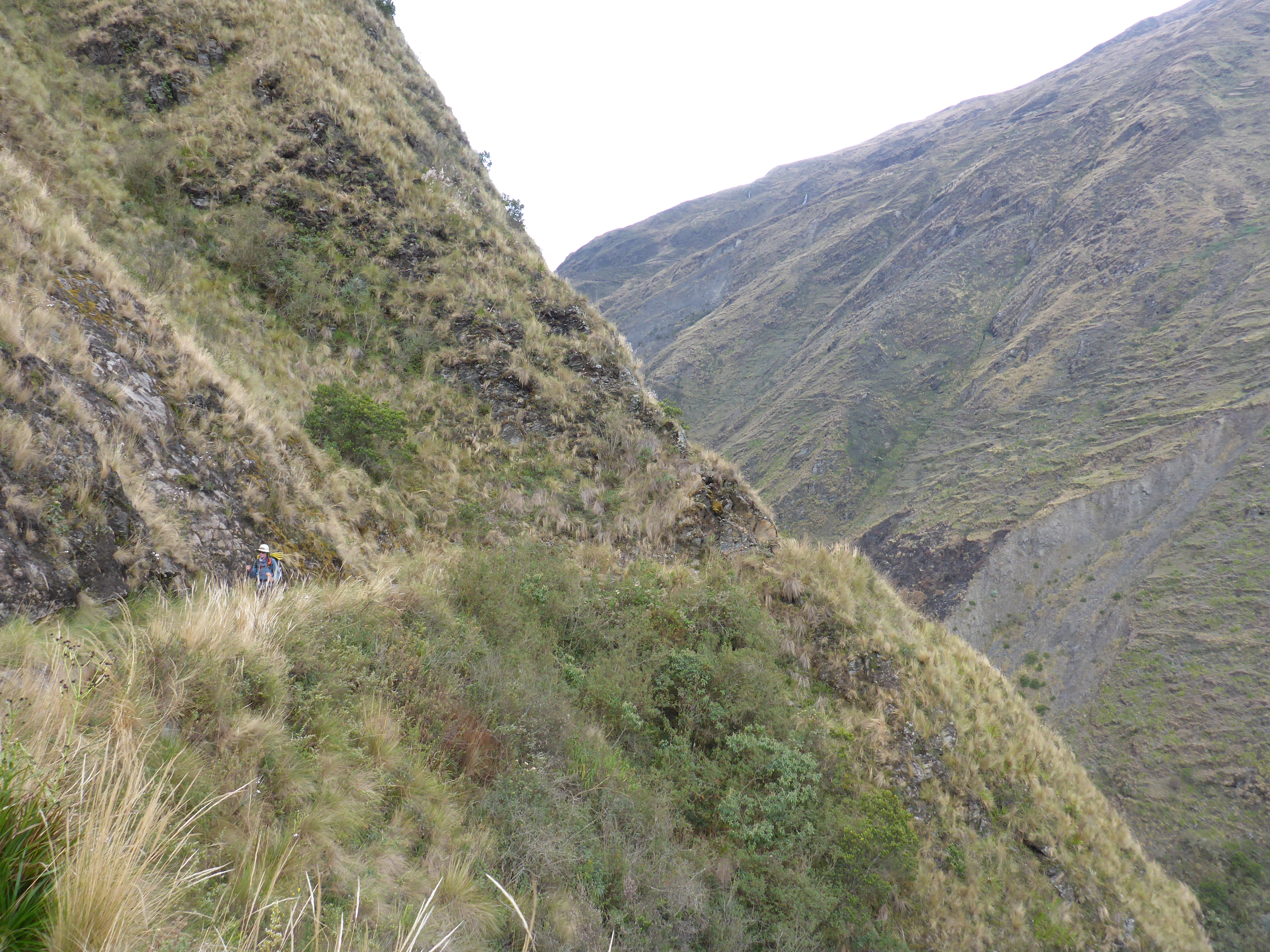
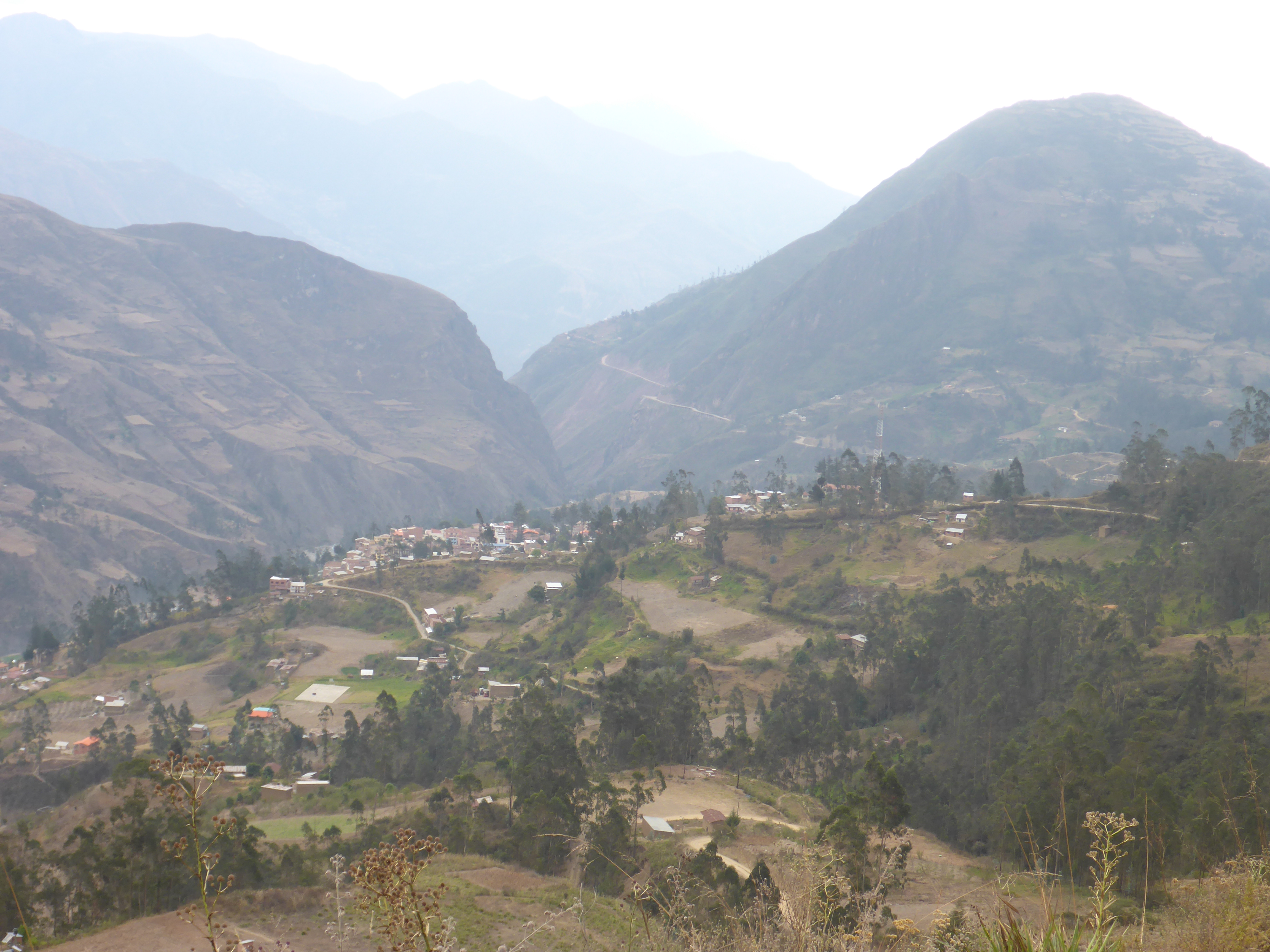
La Paz a Sorata: Cruzando la Cordillera Real
Escrito por Neon
Traduccion por Henry Tovar
Nos abastecimos en La Paz y salimos a un pequeño puesto avanzado de Milluni, ubicado cerca de la base del Cerro Huayna Potosí, una imponente montaña bordeada de glaciares. Saliendo de Milluni, inmediatamente comenzamos nuestra ascensión a nuestro primer paso en la Cordillera Real. Comenzando a una altura de alrededor de 4.000 metros, ascendimos durante la mitad del día hasta aproximadamente 5.100 metros y cruzamos hacia el siguiente valle. Al descender a un pequeño grupo de cabañas, nos dimos cuenta de que era una zona de refugio y comimos algo en el refugio de los pequeños edificios. Cuando salimos de nuestro refugio, el viento se calmó y comenzó el granizo. Afortunadamente, estábamos preparados. El granizo se calmó y marchamos a lo largo del valle para encontrar el campamento para pasar la noche. Terminamos siguiendo un acueducto a un grupo de estanques y montamos nuestra carpa entre un par de ellos para pasar la noche.
A la mañana siguiente, partimos para cruzar otro pase. Me sorprendió lo descansado que me sentí, normalmente no duermo mucho más de 10,000 pies (3050 metros). Continuamos por el extenso valle la mayor parte de la mañana, antes de ganar altura en otro paso justo cuando comenzaba a tener hambre. Afortunadamente, pudimos parar para almorzar y continuar por el paso frente a nosotros. Llegamos a la cima a primera hora de la tarde y nos dirigimos hacia abajo con la esperanza de cruzar el siguiente paso a solo cinco kilómetros y 1.000 metros de descenso y re-ascenso. Fidgit y yo llegamos al fondo del valle a última hora de la tarde / temprano en la noche y decidimos prepararnos para el éxito y no intentar escalar otro paso de 5.100 metros. Había un área para acampar en un extremo del valle, pero no queríamos pagar para armar nuestra carpa así que nos dirigimos a la base de la siguiente subida. Allí, enclavado en la base de las montañas, encontramos un pequeño edificio. Resultó que un grupo de personas del valle se acercó y construyeron un refugio juntos. A medida que los vientos de la tarde se levantaron y las nubes descendieron, decidimos pagar una pequeña tarifa para permanecer en el interior esa noche.
Al despertar a la mañana siguiente ligeramente renovado, subimos y subimos hasta la cima del pase. A medida que nos acercabamos al ápice, crucé algunos pequeños parches de nieve y mi cerebro, que carecía de oxígeno, fue llevado de regreso a la última vez que tuvimos nieve en el camino, en la Patagonia Norte. Recordé mi camino hacia la parte superior del pase, donde Fidgit esperaba pacientemente a descender. Me adelanté en el descenso y me encontré de pie en una repisa sobre un lago glacial, mirando a mi izquierda en un montón de piedras en la cornisa de al lado.
Cuando comencé mi descenso, apareció un hombre pequeño en el fondo de la zona rocosa, preguntándome si estaba bien. Respondí y seguí avanzando con sus ojos puestos en mí. Fidgit apareció en la cornisa y le preguntó al tipo que estaba abajo si ese era el camino hacia abajo. “¡Si, hijo piercas!”, Respondió mientras llegaba a la cornisa con el montículo de piedras y Fidgit comenzó a caminar hacia abajo. Hice un ruido fuerte con mis bastones, y el hombre corrió desde la base de las rocas para asegurarse de que estuviéramos bien. Luego nos ayudó el resto del camino por la zona de ascenso / descenso, y, haciendo caso omiso de sus propios clientes que se habían levantado y estaban descansando, caminó con nosotros a un mirador y señaló el camino para tomar el valle a lo largo un lago. Bajamos a lo largo del lago hasta la base de la siguiente ascensión y nos detuvimos a almorzar. Comenzamos a hablar de nuestra gratitud porque a lo largo de este viaje, la gente parece aparecer en el momento justo. No sé cómo sucede, y sigo estando muy agradecido por ello.
Después del almuerzo, ascendimos a un punto alto que, sentado a apenas 4.700 metros parecía mucho más bajo que los 5.100 metros que acabamos de llegar. Bajamos a otro valle y discutimos el siguiente paso, que era incluso más bajo en elevación. Todavía era lo suficientemente temprano, así que comenzamos nuestro ascenso. Mientras subíamos, algunas nubes rodaban y tuvimos la oportunidad de experimentar nuestra segunda tormenta de granizo de la Cordillera Real, ¡esta vez con la bonificación adicional del trueno! Como no había árboles a la vista durante días, estaba agradecido de no haber visto ningún rayo porque no teníamos más remedio que estar afuera. La tormenta pasó rápidamente, cubriendo todo en blanco y enfriando el aire. Lo hicimos arriba y sobre el paso, descendiendo hasta el borde de un valle más grande y encontrando un lugar más bajo para acampar durante la noche. Me dormí rápidamente después de la cena, agotado por nuestro día de 3 pasos.
Al despertarnos a la mañana siguiente, comenzamos nuestro descenso hacia el valle. Estaba cansado desde el día anterior y gruñón, así que simplemente seguí a Fidgit. Terminamos teniendo que bajar y rodear el valle para volver al otro lado. Fue más largo de lo que me hubiera gustado, pero nos llevó a donde estábamos tratando de llegar. Caminamos sobre otro punto alto, encontrándonos con una manada de llamas y su cuidador en el camino. A medida que avanzabamos hacia el siguiente valle, me di cuenta de que habíamos llegado al valle que planeábamos cruzar desde el lado occidental de las montañas hasta el lado este. Estaba interesado en ver cómo se vería el otro lado de este rango, así que me esforcé mucho más esa tarde. Hicimos alrededor de 2 lagos glaciares gigantes que ocupan la mayor parte del valle, y hasta otro lago antes de encontrar un lugar para acampar y detenernos por la noche. Me arrastré en mi saco de dormir esa noche más cansado de lo que había sentido en mucho tiempo, y dormí profundamente incluso a una altura de 4.300 metros.
Despertándome dolorido, aunque listo, y ajustándose más a la elevación diaria, estaba preparado para el próximo pase. Terminó pareciendo nada porque estaba en un camino de tierra y ya habíamos hecho la mayor parte de la escalada. Entonces, arriba y abajo, fuimos y almorzamos en la base de nuestro primer lado oriental del paso de la Cordillera. Después del almuerzo, nos dirigimos hacia arriba y noté una diferencia bastante inmediata: había muchos más senderos en el lado este de estas montañas. Al menos senderos notables subiendo y bajando el pase. Esto significaba para mí que más humanos (con o sin animales) viajaban por esta área que por el lado occidental de las montañas. Habíamos escuchado eso antes, lo que puede colorear mi perspectiva un poco, pero la notable diferencia en los senderos era más evidencia. Al llegar al paso, inmediatamente comenzamos otro descenso empinado en un valle que seguiríamos. El valle desde arriba parecía un pantano gigante, así que me sentí aliviado cuando miré el GPS y vi un camino que descendía más gradualmente a lo largo del valle para mantenernos alejados de él. Llegamos a dos valles que se unieron y nos preparamos para pasar la noche.
Al día siguiente, pasamos la mayor parte de nuestro tiempo subiendo y subiendo por este hermoso y amplio valle con su río alimentado por glaciares que fluía junto a nosotros. Nosotros, lo adivinaste, llegamos al paso y empezamos a bajar a otro valle. Todavía cansados, llegamos a la base de nuestro descenso y nos preparamos para pasar la noche. En este momento, sabíamos que no llegaríamos a nuestro próximo poblado de reabastecimiento planificado de Sorata en el tiempo que habíamos planeado, y nos estábamos quedando sin comida. Afortunadamente, miramos hacia adelante a lo largo de nuestra ruta y vimos que había una pequeña ciudad un día o dos antes de Sorata. Comenzamos con la esperanza y la planificación de, al menos, encontrar algo allí para sostenernos a través de Sorata.
También teníamos que pasar un pase más antes de que estuviéramos en el valle con la ciudad pequeña, así que descansamos y empujamos a la mañana siguiente, con paquetes más ligeros y determinación. Nos llevó a la tarde para superar el paso, pero a lo largo del descenso el sendero serpenteaba y era fácil de seguir. Llegamos a la ciudad a primera hora de la tarde y, para nuestra agradable sorpresa, fue más grande de lo esperado. Los niños de la ciudad nos dijeron dónde estaba la pequeña tienda y luego nos pidieron dulces. No les dimos ninguno, aunque se mantuvieron de todos modos para mirar a las gringas hasta que sus padres o hermanos mayores se los llevaron. Pasamos el rato en la ciudad, empacando nuestra comida y meriendas, y luego nos mudamos a buscar campamento para pasar la noche en el valle.
A la mañana siguiente nos dirigimos, aliviados de haber encontrado comida, aunque no estaba emocionado por hacer mi paquete más pesado justo antes de una subida empinada. Subimos y salimos del exuberante valle y seguimos un sendero casi visible hacia el siguiente paso. Nos topamos con una guía y sus cargas cerca de la parte superior del pase, y Fidgit recopiló información con la guía mientras hablaba sobre los cargos. Continuamos hacia arriba y el clima era lo suficientemente agradable en la parte superior del pase que tuvimos almorzar allí, bloqueado por el viento por un gran montón de piedras. Luego bajamos. Cerca del fondo del valle, tratamos de forjar nuestro propio camino para evitar caer tan lejos en la elevación antes de volver a ganarlo. Al fallar miserablemente, tuvimos otra aventura en bushwhacking, ya que los primeros árboles que habíamos visto en días aparecieron bastante inconvenientes. Alcanzando nuestro camino hasta el próximo paso para que volviéramos a estar preparados para el éxito, encontramos agua y un área plana para nuestra tienda de campaña. Me instalé para pasar la noche, envolví mi saco de dormir a mi alrededor y hablé con las vacas cercanas mientras mi cena estaba cocinando.
Pasar el último pase antes de que Sorata se estuviera cansando, tanto que atrajimos a algunos cóndores cerca de la cima. Cabalgaron las térmicas perezosamente por encima de nosotros mientras resoplaba y infló el paso de los 4,800 metros. Llegar a la cima a última hora de la mañana y luego negociar cuidadosamente el campo de pedregal en el otro lado fue muy agotador para mí, así que disfruté muchísimo nuestro almuerzo ese día. Fidgit no estaba de humor y se movía lentamente, así que asumí que ella también estaba bastante cansada de esta última semana y medio de esfuerzo a gran altura. Nos arrastramos hacia Sorata, la elevación más baja en la que habíamos estado en muchos días a 2.600 metros. Fue una caminata hermosa, aunque también fue difícil ver hacia dónde se dirige desde tan lejos y no poder llegar más rápido. Terminamos llegando a la ciudad justo a la hora de la cena. Otra sección exitosa realizada me recordó que a pesar de que pueden ser brutales y agotadoras, prefiero caminar por la montaña que caminar por zonas planas y aburridas.
































Comments (9)
Will these recent elevations you’ve covered be some of the highest you do on this journey?
Amazing pictures, I can se why you’re happy to be up and out of the “boring flat land”
What incredible pictures and descriptions.
Thank you
David H
Thank you, David!
These photos have to be the most stunning of the Odyssey to date…be safe girls, always enjoy the read
Gary
Thank you, Gary! It is such astounding landscape it was pretty much impossible to take a bad photo.
Thanks for sharing the running commentary and the breath taking pictures of the mountains and lakes. We are grateful for the way strangers just happen to show up to give you help and advice! The Lord provides for our needs in unexpected ways.
I appreciate your sharing your journey with us. It sounds lovely to me. There are challenges I’m sure but the natural beauty of the surroundings, the daily mini adventures amounting to one epic adventure, and the kindness of strangers seems priceless to a mostly sedentary body.
Thank you for joining us!
While we spend a lot of time alone out there, this journey is very far from solitary. People have a way of showing up right when we need them, be it on trail (at confusing trail junctures, on a rainy afternoon when we’ve run out of food, etc) or off (it is encouraging to get these kinds of notes to know that our writing is reaching people and having an impact).
In a big way, we are lucky to be the middle persons between the journey and those we meet, and those of you who make the time to follow along.